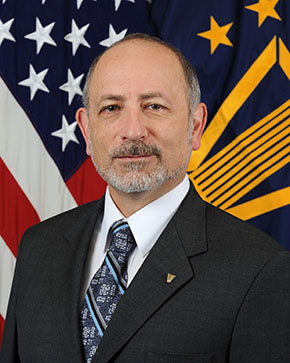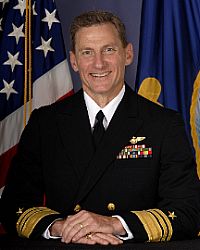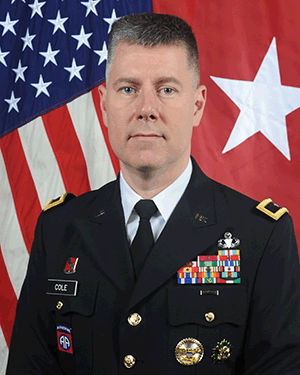In numerous panels and presentations it became clear that the U.S. Armed Forces are increasingly seeing a need to revamp the way they train their service members. We listened in on one important panel discussion – the General/Flag Officer panel, which was quite insightful in revealing the thinking about trends these senior officers see.
 Frank DiGiovanni of the US DoDFrank DiGiovanni from the Department of Defense spoke of the difference between finite games (with agreed upon rules and a game ending) and infinite games (never ending and with no game end) and suggested that latter will always win the day. He said that the formal classroom style training is a “Victorian era relic that needs to be completely transformed” to take advantage of new technologies and training methodologies. What is needed are new types of leaning like action learning, contextural learning, and connectivism with ‘virtual tribes’. Learning and pushing the envelope is an infinite game.
Frank DiGiovanni of the US DoDFrank DiGiovanni from the Department of Defense spoke of the difference between finite games (with agreed upon rules and a game ending) and infinite games (never ending and with no game end) and suggested that latter will always win the day. He said that the formal classroom style training is a “Victorian era relic that needs to be completely transformed” to take advantage of new technologies and training methodologies. What is needed are new types of leaning like action learning, contextural learning, and connectivism with ‘virtual tribes’. Learning and pushing the envelope is an infinite game.
He also suggested that we think about the learning business model. With a distributed learning environment, is it best to think about just picking a series of providers and hoping they meet the needs? Maybe is it better to think of this as “modeling and simulation as a service” which might open up more innovation.
He challenged those in the audience to also think about developing new training and education tools to develop social communication methods to “win the battle of the narrative.” Likewise, cyber warfare is and will continue to be a significant threat. Hackers learn their skills in 6 months while we train our cyber security experts using a 4-year formal education program and 6 months of practical knowledge. He questioned whether it was prudent to continue this approach. “The hackers are using high velocity learning so the equation doesn’t look too good for the good guys.”
DiGiovanni noted that a large gap exists between what we will need for the knowledge worker of the future and the training and education capabilities of current institutions.
Decision Making Needs Pushing Down
Dennis C ThompsonDennis Thompson from the Marine Corps stressed the need to push decision making down the chain to lower levels and to get more “reps and sets” to enhance training. He likes the idea of AR and VR to help achieve this goal.
He then described three lines of effort in this area. Decision making is about taking the experience of a 20-year veteran and instilling this in less senior Marines. One area is upgrading of the command-level simulation capabilities to give more ‘repetitions and sets’ and link together more simulation modules. At the lower levels, he described new virtual training tools that the squad leaders can use before going on live field training exercises. They are also looking at tools to create 3D maps that can be accessible via Hololens. This includes the ability to fly a drone over an area and quickly download data into a simulation for training.
Immersive collective training is being developed in a number of facilities that integrates all kinds of VR technologies to allow training along with the all important after training review to understand “why you did you do what you did.” The Marine Corps are trying to get to the point where you cannot shoot a live round until you have done it in a simulator, which optimizes the live training part.
He said they are also going to deploy about 600 AR systems for Joint Tactical Air Command (JTAC) and other training needs that allows presentation of virtual targets and get some feedback. They hope this can be used as an organic, in-field JTAC certification tool, which will save a lot time and effort.
In networking, the Marines clearly see a need to expand the linking of virtual trainers. They have a new project to link three virtual and two constructive simulations on a permanent basis. Again, the idea is to optimize live field training, but Thompson acknowledged they need the help of industry to realize these capabilities.
 Paul GrosklagsVice Admiral Paul Grosklags of Naval Air Systems Command said he came to I/ITSEC last year as a skeptic but he is now a huge advocate of simulation. He really understands now how important these tools are for flight line readiness and bringing new capabilities on line more quickly.
Paul GrosklagsVice Admiral Paul Grosklags of Naval Air Systems Command said he came to I/ITSEC last year as a skeptic but he is now a huge advocate of simulation. He really understands now how important these tools are for flight line readiness and bringing new capabilities on line more quickly.
He said the Navy has the planes, but not enough are operational at any time to meet their readiness needs. Improving this is part of a major Navy initiative called Sailor 2025 that includes simulation and training. He described their current training process as sequential; you first learn a trade and then learn it on various platforms. The shortcoming of this is insufficient ability to refresh previous training to solidify the knowledge – especially if it has been a few years and the knowledge is now needed.
Today the need is being met with training videos for certain procedures that act as refreshers. But they want to implement “ready relevant learning” that is more systemic. The Marines are just getting started in this and are currently developing the curriculum. The second piece is the delivery methods – schoolhouse, laptop or VR environment – they are still trying to figure this out.
He also noted that the Navy’s training capabilities often lag behind the operation capabilities of various systems, which is a problem for effective training. But, in addition, training personnel on new upgrades doesn’t happen fast enough. These are both roadblocks to doing faster upgrades to systems – something they deem very important. Thompson sees Live Virtual Constructive (LVC) training as the key. But what is missing is a requirements roadmap. Next month, a new draft document called Ship and Aircraft Training Capability will be issued. This is intended to guide how these requirements are turned into solutions.
Major General Scott West from the Air Force could not “overstate the value of virtual and constructive training”, however, live training will remain key because it “operates the entire operational chain.” He sees the value in the reduction of learning time or reducing the atrophy or decay in learning. Virtual-constructive needs to play a role in nuclear arms training and in management of assets in space as well.
Train, advise and assist is the mission of many of the Air Force personnel – particularly for partners, while the second key mission is support of counterterrorism operations. “But the most challenging scenarios are operations in contested air spaces and we need to be ready for those potential conflicts. We are a little behind where we want to be in terms of readiness for a conflict with a near peer and this is where virtual-constructive training can really help.” And, he wants to be able to do this at the airman’s home station so they can be close to family and not have to constantly deploy for training.
Brig General Athanasios Tsouganatos represented NATO and said that the more prepared the partners are the better. “NATO has used simulation for many years and it is an essential part of the training, but we have not explored all the possibilities of modeling and simulation. NATO partners want more realistic scenarios, more accurate data and models and continuous training between exercises.”
NATO consists of 28 countries and getting them to agree on any direction is not an easy task. But he thinks industry, academia and the military need to explain the benefits of modeling and simulation in a clear and simple way. Specifically, he needs industry to help in developing services and tool sets for the command structure. The second needed area of help is multi-national self training. Here, he sees the U.S. as mature in its LVC capabilities so the question is how to extend this to NATO partners. He looks to industry to help address these issues.
Serious Games
 BG William ColeBrig General William Cole for the U.S. Army noted that today there are serious games that do help war fighters hone their skills. He said that the Army’s simulators were initially built independently but starting in 2012, they began to network them together via the LVC Integrating Architecture. This is now routinely used, especially by armored brigades that use all three types of assets: live, virtual and constructive. This allows many repetitions of the fight scenarios over the typical two week training period.
BG William ColeBrig General William Cole for the U.S. Army noted that today there are serious games that do help war fighters hone their skills. He said that the Army’s simulators were initially built independently but starting in 2012, they began to network them together via the LVC Integrating Architecture. This is now routinely used, especially by armored brigades that use all three types of assets: live, virtual and constructive. This allows many repetitions of the fight scenarios over the typical two week training period.
Going forward, he would like to see a fusing of gaming and constructive modeling with augmented reality to link with live training. The problem is that soldiers who are participating in the live aspect of the training can’t see their constructive or virtual counterparts. He hopes there is an augmented reality solution to this problem.
He also wants automated tutors that are tailored to each soldier, and he wants better after action review tools as well.
Cole then described another war fighting exercise which he said was akin to a “giant game of laser tag”, where soldiers, vehicles and now helicopters are all outfitted with lasers and laser sensors. This will soon be added as a virtual capability.
In medical modeling, the US Army is creating partnering programs to improve the quality of medical care and are seeing success with greatly reduced mortality rates on the battle field. Now, the medical personnel have an advanced manikin and tool sets they can take with them into the field to maintain their proficiency.
For cyber training, Cole sees a need for a training range as you can’t use the Internet. There are a few “cyber ranges” now, but they will expand these and work to connect them in the future.
Q&A Session
In the question and answer part of the panel, the first question focused on determining how the military can leverage the massive investments that commercial companies are making in AR/VR/MR technology and applications.
DiGionvanni said that there has been some reluctance from the government and military sectors to engage with industry, but “we no longer have that luxury. We need to be more open, but follow the rules, which means that what you do for one, you must do for all.”
Grosklags said we have no choice. “We can never keep up with the technology change, or if we try, it won’t happen as fast. Our procurement process is too slow. By the time we are ready to purchase, industry has already moved on to the next generation, so we have to figure out how to do this faster and make the discussion more relevant for industry as well. We need to accept commercial technology ‘as is’, even if it only meets 80% of our requirements. 80% of something we can get today is much better than 100% of something we can get in five years.”
“Who is winning the battle between the folks who want to build joint integrated systems vs. the security people who fear unwarranted access?” was the next question. General West said “each nation will have its own requirements to protect information, but we also have to be able to build open architectures for virtual and constructive simulations. This is critical for rapid updating. There will always be some tension here.”
Grosklags acknowledged the challenge of leveraging the commercial market place while still giving due diligence to the real cyber thereat we face in operational and training systems. “We have to find where the line is and we need to find this balance and there is a lot of work to be done there.”
DiGiovanni said he has heard that industry is reducing its investment in cyber security, which he noted is a dangerous thing. “Maybe there are some advanced cyber capabilities that industry can leverage from the military?” He also likes the idea of developing the relationship between artificial intelligence (AI) and the human, but cautioned to not become too dependent upon AI.
How are the services working together to create joint training environments? Gen. Cole noted that he had just returned from Korea and an exercise that indeed brought together all the services in a joint simulation. DiGiovanni said that he thinks the DoD needs to keep funding programs to specifically address this gap and encourage inter-service dialog.
That concluded the panel discussion. – CC

